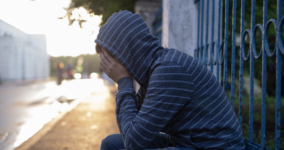Australian Study Confirms Link Between Violence in the Home and Sexual Offending

New research by Griffith University in Queensland has confirmed that which may seem obvious to many: that boys who have been exposed to violence in the home are far more likely to commit sexual offences.
The research emphasises two important points which can inform government policy and expenditure.
The first is that being exposed to violence is a contributing factor when it comes to sexual offending – a finding that supports calls for greater funding of intervention programs.
The second is that punitive responses punitive responses to youth offending are counter-productive in so far as they do not reduce re-offending, but rather increase them.
Offenders are victims themselves
The research shows that almost 60% of boys referred to a Queensland forensic service for sexual assault offences were exposed to domestic or family violence before they offended, or suffered emotional neglect, or had a caregiver who engaged in substance abuse.
While the researchers qualify their finding by making clear that data regarding the general population is limited, the numbers support what those on the frontline such as counsellors and psychologists have been saying for decades – damaged people damage others, and support services as well as intervention are key to breaking the cycle of violence.
The researchers urge policy makers to focus on these key areas to reduce offending and thereby protect the community.
Punitive responses counter-productive
The researchers remark that while being ‘tough on crime’ is politically popular, it does not result in responses that are beneficial to those who are victims of crime themselves, let alone society as a whole.
In that regard, there’s a wealth of research that incarceration, especially that which is signified by harsh treatment in youth detention centres, fosters aggression and violence and has the potential to turn impressionable youths which might otherwise get back on the right road into repeat offenders.
Treatment-based approaches benefit all
The desperate need for treatment-based approaches is supported by other Australian research, including a study by the National Research Organisation for Women’s Safety (ANROW).
That organisation surveyed 5,000 young people aged between 16 and 20, finding that one in five young people reported using family violence, including physical, emotional, psychological, verbal, financial and / or sexual abuse.
Of these young people, 89% who used family violence “episodically” reported previous experiences of child abuse. This increased to 96% amongst young people who reported frequent use of family violence against one or more family members.
In the ANROW study, the most common forms of family violence reported were verbal abuse (15%), physical violence (10%) and emotional/psychological abuse (5%).
The results also showed that siblings and mothers were most at risk of being victims of adolescent family violence.
Around 51% of the young people who had used violence in the home had done so against their mother, while 68% had used violence against a sibling (including step-siblings). Furthermore, young people with a disability, and young people who identified as having a diverse gender and/or sexual identity, were more likely to use family violence. They were also more likely to have been subjected to violence in the home.
Intergenerational impact of family violence
The research outlines the intergenerational impact of family violence and shows why addressing family violence needs to be an urgent national priority.
While Governments at Federal and State level continue to invest billions of dollars into a range of domestic and family violence initiatives, the bulk of this funding tends to be for services which support victims, and while these are vital, much more needs to be done in the areas of early intervention and prevention if we are to successfully stem the tide.
Critically, the research raises something that is not often talked about – sexual assault and family violence are not solely a “women’s issue.”
Yes, gendered violence is a significant problem – long-term statistics, not just in Australia, but globally, show that women tend to be the vast majority of victims of violence, particularly sexual and domestic violence, but these bodies of research clearly point to the fact that this is a much broader social problem that, unless fixed, will result, over time, in an increasingly aggressive and violent society.
To a large extent this is already playing out – statistics show that levels of domestic and family violence are higher than ever before, exacerbated by Covid lockdowns. Recent figures suggest that family violence during the COVID-19 pandemic will cost the NSW economy more than $3 billion by 2025, with estimates 60,000 women experienced abuse for the first time in 2020.
While it is possible that perhaps the increase in numbers in recent years could be attributed to a greater focus on reporting, this is not necessarily the case. We know that significant numbers of men are victims of domestic and family violence and these numbers are vastly under-reported.







